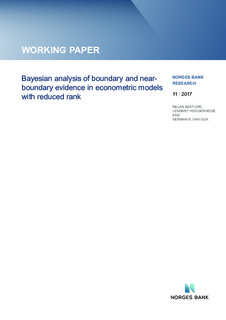| dc.description.abstract | Weak empirical evidence near and at the boundary of the parameter region is a predominant feature in econometric models. Examples are macroeconometric models with weak information on the number of stable relations, microeconometric models measuring connectivity between variables with weak instruments, financial econometric models like the random walk with weak evidence on the efficient market hypothesis and factor models for investment policies with weak information on the number of unobserved factors. A Bayesian analysis is presented of the common issue in these models, which refers to the topic of a reduced rank. Reduced rank is a boundary issue and its effect on the shape of the posteriors of the equation system parameters with a reduced rank is explored systematically. These shapes refer to ridges due to weak identification, fat tails and multimodality. Discussing several alternative routes to construct regularization priors, we show that flat posterior surfaces are integrable even though the marginal posterior tends to infinity if the parameters tend to the values corresponding to local non-identification. We introduce a lasso type shrinkage prior combined with orthogonal normalization which restricts the range of the parameters in a plausible way. This can be combined with other shrinkage, smoothness and data based priors using training samples or dummy observations. Using such classes of priors, it is shown how conditional probabilities of evidence near and at the boundary can be evaluated effectively. These results allow for Bayesian inference using mixtures of posteriors under the boundary state and the near-boundary state. The approach is applied to the estimation of education-income effect in all states of the US economy. The empirical results indicate that there exist substantial differences of this effect between almost all states. This may affect important national and state-wise policies on required length of education. The use of the proposed approach may, in general, lead to more accurate forecasting and decision analysis in other problems in economics, finance and marketing. | nb_NO |

